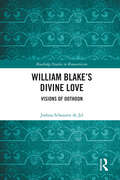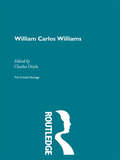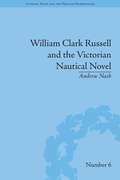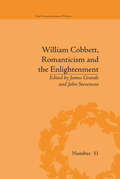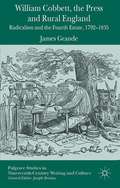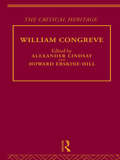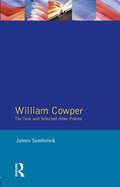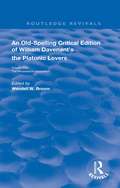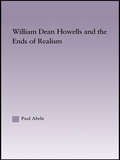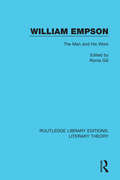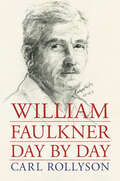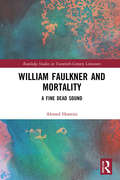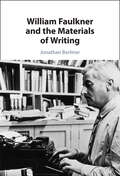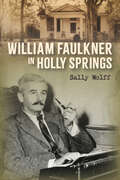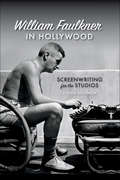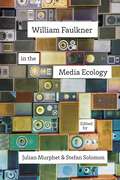- Table View
- List View
William Blake’s Divine Love: Visions of Oothoon (Routledge Studies in Romanticism)
by Joshua Schouten de JelDespite the fact that William Blake summarises the plot of Visions of the Daughters of Albion (1793) in just eight lines in the prefatory ‘Argument,’ there are several contentious moments in the poem which continue to cause debate. Critics read Oothoon’s call to Theotormon’s eagles and her offer to catch girls of silver and gold as either evidence of her rape-damaged psyche or confirmation of her selfless love which transcends her socio-sexual state. How do we reconcile the attack of Theotormon’s eagles and the wanton play of the girls with Oothoon’s articulate and highly sophisticated expressions of spiritual truth and free love?In William Blake’s Divine Love: Visions of Oothoon, Joshua Schouten de Jel explores the hermeneutical possibilities of Oothoon’s self-annihilation and the epistemological potential of her visual copulation by establishing an artistic and hagiographical heritage which informs the pictorial representation and poetic pronunciation of Oothoon’s enlightened entelechy. Working with Michelangelo’s The Punishment of Tityus (1532) and Gian Lorenzo Bernini’s Ecstasy of Saint Teresa (1647–51), Oothoon’s ecstatic figuration reflects two iconographic traditions which, framed by the linguistic tropes of divine love expressed within a female-centred mystagogy, reveal the soteriological significance of Oothoon’s willing self-sacrifice.
William Carlos Williams
by Charles DoyleThis set comprises of 40 volumes covering nineteenth and twentieth century European and American authors. These volumes will be available as a complete set, mini boxed sets (by theme) or as individual volumes. This second set compliments the first 68 volume set of Critical Heritage published by Routledge in October 1995.
William Clark Russell and the Victorian Nautical Novel: Gender, Genre and the Marketplace (Literary Texts and the Popular Marketplace #6)
by Andrew NashWilliam Clark Russell wrote more than forty nautical novels. Immensely popular in their time, his works were admired by contemporary writers, such as Conan Doyle, Stevenson and Meredith, while Swinburne, considered him 'the greatest master of the sea, living or dead'. Based on extensive archival research, Nash explores this remarkable career.
William Cobbett, Romanticism and the Enlightenment: Contexts and Legacy (The Enlightenment World #31)
by James GrandeCobbett was one of the greatest journalists of his day. Following a career in the British army he began writing as the loyalist 'Peter Porcupine' in the United States, defending all things British against the French Revolution and its supporters. This is the first collection on Cobbett and contains essays by scholars from a variety of disciplines.
William Cobbett, the Press and Rural England
by James GrandeWilliam Cobbett, the Press and Rural England offers a thorough re-appraisal of the work of William Cobbett (1763-1835), examining his pioneering journalism, identification with rural England and engagement with contemporary debates. It offers a new interpretation of Cobbett as a Burkean radical, whose work cuts across the 'revolution controversy' of the 1790s and combines Tom Paine's common sense and transatlantic radicalism with Edmund Burke's emphasis on tradition, patriotism and the domestic affections. To Hazlitt, Cobbett came to represent 'a kind of fourthestate in the politics of the country', becoming the virtual embodiment of both rural England and the campaign for parliamentary reform. This study draws on Cobbett's published writings and unpublished correspondence to show how he achieved this status. Individual chapters focus on his writings as Peter Porcupine, publication of parliamentary debates, imprisonment in Newgate, exile on Long Island, role in the Queen Caroline affair, Rural Rides, his prosecution after the Captain Swing riots and his wide-ranging legacies.
William Congreve: The Critical Heritage (Critical Heritage Ser.)
by Howard Erskine-Hill Alexander LindsayThe Critical Heritage gathers together a large body of critical sources on major figures in literature. Each volume presents contemporary responses to a writer's work, enabling student and researcher to read the material themselves.
William Cowper: The Task and Selected Other Poems
by James SambrookHaving previously suffered neglect as a result of Pope's dominance of the period, William Cowper (1731-1800) has now become a far more important figure in eighteenth-century literature. Following the successful format of the series, Professor Sambrook's edition consists of a comprehensive, contextual editor's introduction together with substantial annotation on the page. The Task (1785) is the principal text discussed together with a selection of Cowper's other poems which cover a wide range of his subjects, moods and styles.
William Davenant’s The Platonic Lovers (Routledge Revivals)
by Wendell W. BroomFirst published in 1987, this 23rd volume in the Renaissance Imagination series had the objective of establishing the text of William Davenant’s The Platonick Lovers that most closely represents the author’s final vision for his work. Wendell W. Broom Jr documents the history of the publication of The Platonick Lovers and the manner in which the present text was produced. Copies of all relevant editions have been collated and curated to bring together the definitive authorial version of the text.
William Dean Howells and the Ends of Realism (Studies in Major Literary Authors)
by Paul AbelnDespite efforts at revival by John Updike and others, William Dean Howells still remains in the shadows of his close friends Mark Twain and Henry James. This book works against decades of unfavorable comparisons with these literary giants. William Dean Howells and the Ends of Realism helps us to see him as a writer very much aware of his limitations and of his enormous importance in the development of an American literary tradition. A close look at his late works gives us a richer understanding of this powerful moment of transition in American literature, a moment when Howells and his venerable friends were inspiring and anointing a new generation of writers and taking a long, hard look at their own legacies and contributions.
William Empson: The Man and His Work (Routledge Library Editions: Literary Theory #14)
by Roma GillThis volume of commemorative and celebratory essays, first published in 1974, concentrates on William Empson – the critic, the poet and friend. The papers range from the biographical to the academic, but what every one suggests is the impossibility of separating the man from his work and the ‘life’ from the ‘thought’. This book constitutes an important study of Empson, his work and his impact upon people and literary studies of our time.
William Faulkner (Comprehensive Research and Study Guide)
by Harold BloomCommentary on the author's major works and on his life.
William Faulkner Day by Day
by Carl RollysonWilliam Faulkner has been the topic of numerous biographies, papers, and international attention. Yet there are no collected resources providing a comprehensive scope of Faulkner’s life and work before now. William Faulkner Day by Day provides unique insight into the daily life of one of America’s favorite writers. Beyond biography, this book is an effort to recover the diurnal Faulkner, to write in the present tense about past events as if they are happening now. More importantly, this book is concerned with more than the writer’s life. Instead, it examines the whole man—the daily, mundane, profound, life changing, and everything in between. Spanning from the 1825 birth of Faulkner’s great-grandfather to Faulkner’s death 137 years later to the day, author and biographer Carl Rollyson presents for the first time a complete portrait of Faulkner’s life untethered from any one biographical or critical narrative. Presented as a chronology of events without comment, this book is accompanied by an extensive list of principal personages and is supported by extensive archival research and interviews. Populated by the characters of Faulkner’s life—including family and friends both little known and internationally famous—this book is for Faulkner readers of all kinds with a wide variety of interests in the man and his work.
William Faulkner and Mortality: A Fine Dead Sound (Routledge Studies in Twentieth-Century Literature)
by Ahmed HoneiniWilliam Faulkner and Mortality is the first full-length study of mortality in William Faulkner’s fiction. The book challenges earlier, influential scholarly considerations of death in Faulkner’s work that claimed that writing was his authorial method of ‘saying No to death’. Through close-readings of six key works – The Sound and the Fury, As I Lay Dying, "A Rose for Emily", Light in August, Absalom, Absalom!, and Go Down, Moses – this book examines how Faulkner’s characters confront various experiences of human mortality, including grief, bereavement, mourning, and violence. The trauma and ambivalence caused by these experiences ultimately compel these characters to ‘say Yes to death’. The book makes a clear distinction between Faulkner’s quest for literary immortality through writing and the desire for death exhibited by the principal characters in the works analysed. William Faulkner and Mortality: A Fine Dead Sound offers a new paradigm for reading Faulkner’s oeuvre, and adds an alternative voice to a debate within Faulkner scholarship long thought to have ended.
William Faulkner and Southern History
by Joel WilliamsonTraces Faulkner's ancestry and life, then relates this material to his writings.
William Faulkner and the Materials of Writing
by Jonathan BerlinerWilliam Faulkner and the Materials of Writing examines the many physical texts in Faulkner's novels and stories from letters and telegrams to Bibles, billboards, and even the alphabetic shape of airport runways. Current investigations in print culture, book history, and media studies often emphasize the controlling power of technological form; instead, this book demonstrates how media should be understood in the context of its use. Throughout Faulkner's oeuvre, various kinds of writing become central to characters forming a sense of the self as well as bonds of intimacy, while ideologies of race and gender connect to the body through the vehicle of writing. This book combines close reading analysis of Faulkner's fiction with the publication history of his works that together offer a case study about what it means to live in a world permeated by media.
William Faulkner in Context
by John T. MatthewsWilliam Faulkner in Context explores the environment that conditioned Faulkner's creative work. This book provides a broad and authoritative framework that will help readers to better understand this widely read yet challenging writer. Each essay offers a critical assessment of Faulkner's work as it relates to such topics as genre, reception, and the significance of place. Although Faulkner dwelt in his native Mississippi throughout his life, his visits to cities like New Orleans, Paris, and Hollywood profoundly shaped his early career. Inextricable from the dramatic upheavals of the twentieth century, Faulkner's writing was deeply affected by the Great War, the Great Depression, World War II, and the civil rights movement. In this volume, a host of renowned scholars shed light on this enigmatic writer and render him accessible to students and researchers alike.
William Faulkner in Holly Springs
by Sally WolffWilliam Faulkner in Holly Springs describes places and people in this small Mississippi town and defines how these newly identified individuals and locales affected Faulkner’s writings. Author Sally Wolff uncovers new information about Faulkner’s sources and examines how the town of Holly Springs, its people, and its culture influenced the Nobel Laureate and the literature he produced. Wolff argues that this information can serve as touchstone sources for some of Faulkner’s most renowned fiction, including The Sound and the Fury, Absalom, Absalom!, Intruder in the Dust, and Requiem for a Nun.Information from various interviews with over twenty current and former citizens of Holly Springs also helps to reveal Faulkner’s presence in this small town and the ways in which he drew from and then transformed what he found there into some of the greatest works in American letters. A clearer understanding of Faulkner’s sources helps elucidate the breadth of creativity and imagination with which he forged his world-famous literature.
William Faulkner in Hollywood: Screenwriting for the Studios (The South on Screen)
by Stefan SolomonA scholarly examination of the scripts and fiction Faulkner created during his foray as a Hollywood screenwriter. During more than two decades (1932-1954), William Faulkner worked on approximately fifty screenplays for major Hollywood studios and was credited on such classics as The Big Sleep and To Have and Have Not. Faulkner&’s film scripts—and later television scripts—constitute an extensive and, until now, thoroughly underexplored archival source. Stefan Solomon analyzes the majority of these scripts and also compares them to the fiction Faulkner was writing concurrently. His aim: to reconcile two aspects of a career that were not as distinct as they first might seem: Faulkner the screenwriter and Faulkner the modernist, Nobel Prize–winning author. As Solomon shows Faulkner adjusting to the idiosyncrasies of the screenwriting process (a craft he never favored or admired), he offers insights into Faulkner&’s compositional practice, thematic preoccupations, and understanding of both cinema and television. In the midst of this complex exchange of media and genres, much of Faulkner&’s fiction of the 1930s and 1940s was directly influenced by his protracted engagement with the film industry. Solomon helps us to see a corpus integrating two vastly different modes of writing and a restless author. Faulkner was never only the southern novelist or the West Coast &“hack writer&” but always both at once. Solomon&’s study shows that Faulkner&’s screenplays are crucial in any consideration of his far more esteemed fiction—and that the two forms of writing are more porous and intertwined than the author himself would have us believe. Here is a major American writer seen in a remarkably new way.
William Faulkner in the Media Ecology (Southern Literary Studies)
by Richard Godden Robert Jackson Julian Murphet John T. Matthews Mark Steven Stefan Solomon Sarah Gleeson-White Donald Kartiganer Catherine G. Kodat Peter Lurie Sascha Morrell Jay Watson Michael ZeitlinWilliam Faulkner in the Media Ecology explores the Nobel Prize-winning author immersed in the new media of his time. Intersecting with twentieth-century technology such as photography, film, and sound recording, these twelve essays portray Faulkner as not only as a writer looking back on the history of the U.S. South, but also as a screenwriter, aviator, and celebrity. This fresh, interdisciplinary approach to Faulkner presents an innovative way of reassessing a body of literary work that has engaged readers and critics for over sixty years. Essays by John T. Matthews, Catherine Gunther Kodat, Stefan Solomon, and Donald M. Kartiganer assess how Faulkner's legacy has been shaped through media adaptation and public commemoration of his work. Jay Watson, Michael Zeitlin, Sarah Gleeson-White, Robert Jackson, and Sascha Morrell consider a range of media relevant to the creation of the writer's stories and ways to recalibrate traditional thinking about his writing. Mark Steven, Peter Lurie, and Richard Godden examine how the vastly different mediations of both cinema and money influenced Faulkner's work. Editors Julian Murphet and Stefan Solomon have brought together some of the most prominent voices in Faulkner studies, along with a number of emerging scholars, to construct a portrait of Faulkner as a thoroughly modern writer, as much attuned to the evolution of the contemporary world as he was to the past.
William Faulkner of Yoknapatawpha County
by Lewis LearyOne of a series entitled Twentieth Century American Writers.
William Faulkner's 'Absalom, Absalom!: A Critical Casebook (Routledge Library Editions: The American Novel #13)
by Elisabeth MuhlenfeldOriginally published in 1984. William Faulkner is the most studied American author of our time. This volume presents a collection of some of the best critical essays on William Faulkner’s ninth novel Absalom, Absalom!. Numerous approaches are represented; among them are theme studies, close readings, psychological studies, source studies, structural studies, and analyses of style and narrative technique.
William Faulkner's Characters: An Index to the Published and Unpublished Fiction (Routledge Library Editions: The American Novel #5)
by Thomas E. DasherOriginally published in 1981. This index to characters and names in the published and unpublished fiction of William Faulkner is in two parts. The first, divided into novels, short stories, and unpublished fiction, lists the characters within each individual work. The second is an index of all named characters. Within each division of the first part of the index, works are listed alphabetically. The characters and names in each work are divided into fictional, unnamed, historical, Biblical and literary/mythic. The Master Index of named characters is a conflation of all the fictional characters as well as historical/Biblical/literary/mythic characters and names which appear in all the fiction. All characters are identified as clearly and succinctly as possible without interpretation of their roles.
William Faulkner's Gothic Domain
by Elizabeth M. KerrFrom the book: "The term "Gothic" unfortunately has pejorative connotations which we must recognize before giving it the comprehensive definition necessary to an examination of the pervasive Gothic elements in William Faulkner's Yoknapatawpha novels. In current literary criticism "Gothic" either refers in the historical sense to the Gothic novel as a subgenre, from Horace Walpole through his literary successors such as Ann Radcliffe, Matthew Gregory Lewis, and Charles Maturin, or is loosely applied to various aspects of serious modern novelists such as Faulkner and Carson McCullers."
William Faulkner's Light in August (Modern Critical Interpretations)
by Harold BloomEssays from various critics.
